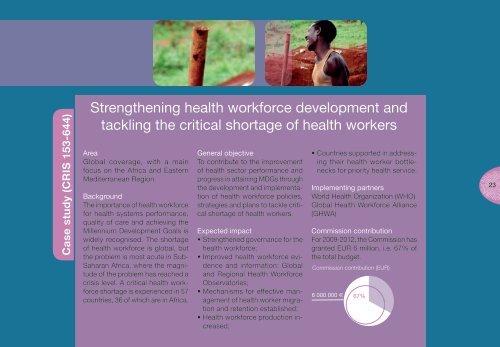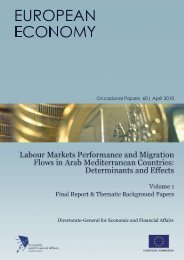Introduction to the thematic instruments and programmes 2011-2013
Introduction to the thematic instruments and programmes 2011-2013
Introduction to the thematic instruments and programmes 2011-2013
Create successful ePaper yourself
Turn your PDF publications into a flip-book with our unique Google optimized e-Paper software.
Case study (CRIS 153-644)<br />
Streng<strong>the</strong>ning health workforce development <strong>and</strong><br />
tackling <strong>the</strong> critical shortage of health workers<br />
Area<br />
Global coverage, with a main<br />
focus on <strong>the</strong> Africa <strong>and</strong> Eastern<br />
Mediterranean Region.<br />
Background<br />
The importance of health workforce<br />
for health systems performance,<br />
quality of care <strong>and</strong> achieving <strong>the</strong><br />
Millennium Development Goals is<br />
widely recognised. The shortage<br />
of health workforce is global, but<br />
<strong>the</strong> problem is most acute in Sub-<br />
Saharan Africa, where <strong>the</strong> magnitude<br />
of <strong>the</strong> problem has reached a<br />
crisis level. A critical health workforce<br />
shortage is experienced in 57<br />
countries, 36 of which are in Africa.<br />
General objective<br />
To contribute <strong>to</strong> <strong>the</strong> improvement<br />
of health sec<strong>to</strong>r performance <strong>and</strong><br />
progress in attaining MDGs through<br />
<strong>the</strong> development <strong>and</strong> implementation<br />
of health workforce policies,<br />
strategies <strong>and</strong> plans <strong>to</strong> tackle critical<br />
shortage of health workers.<br />
Expected impact<br />
• Streng<strong>the</strong>ned governance for <strong>the</strong><br />
health workforce;<br />
• Improved health workforce evidence<br />
<strong>and</strong> information: Global<br />
<strong>and</strong> Regional Health Workforce<br />
Observa<strong>to</strong>ries;<br />
• Mechanisms for effective management<br />
of health worker migration<br />
<strong>and</strong> retention established;<br />
• Health workforce production increased;<br />
• tion Countries <strong>and</strong> retention supported established; in addressing<br />
<strong>the</strong>ir workforce health worker production bottle-<br />
in-<br />
• Health<br />
creased; necks for priority health service.<br />
• Countries supported in address-<br />
Implementing <strong>the</strong>ir health partners worker bottlenecks<br />
Health for priority Organization health service. (WHO)<br />
World<br />
Global Health Workforce Alliance<br />
Implementing (GHWA) partners<br />
World Health Organization (WHO)<br />
Global Commission Health contribution Workforce Alliance<br />
(GHWA) For 2009-2012, <strong>the</strong> Commission has<br />
granted EUR 6 million, i.e. 67% of<br />
Commission <strong>the</strong> <strong>to</strong>tal budget. contribution<br />
For Commission 2009-2012, contribution <strong>the</strong> Commission (EUR) has<br />
granted EUR 6 million, i.e. 67% of<br />
<strong>the</strong> <strong>to</strong>tal budget.<br />
6 000 000 e 75% 67%<br />
23

















